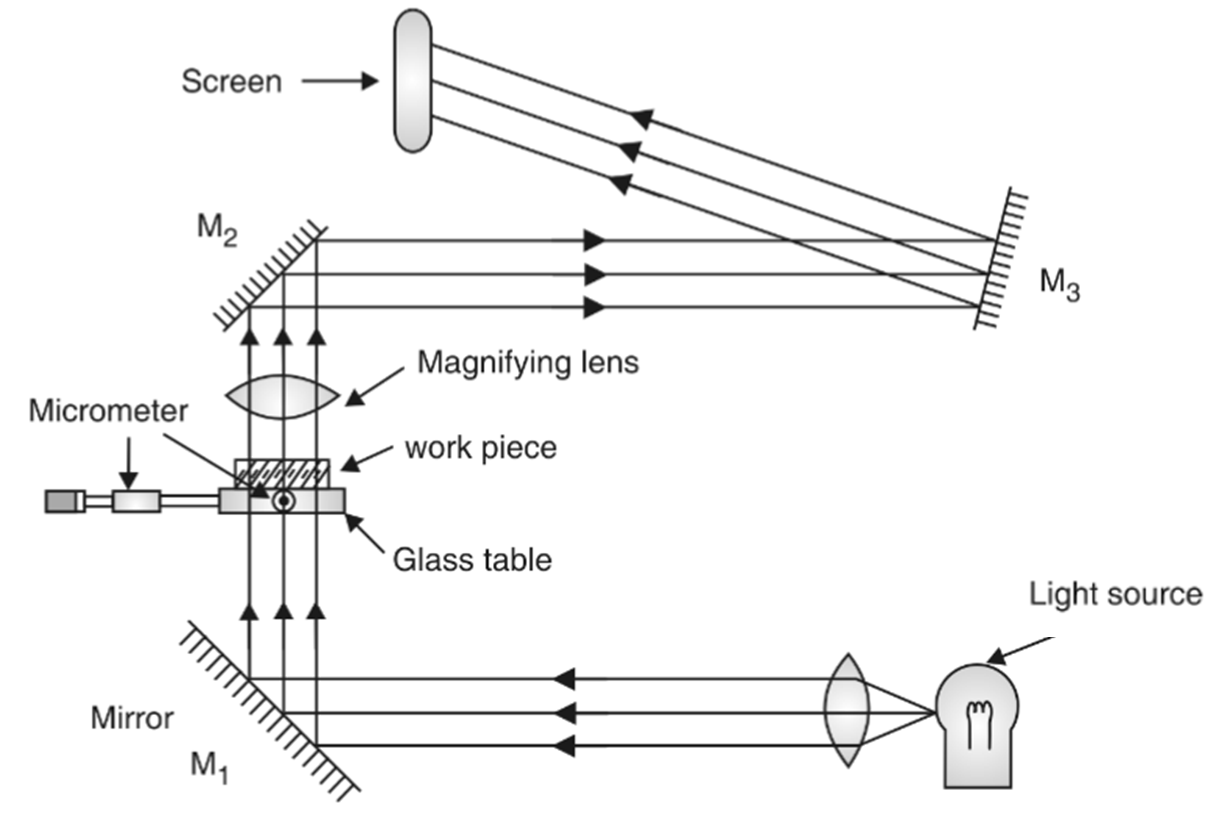A profile projector, also known as an optical comparator, is a metrological device used to measure and inspect the dimensions of manufactured components with high precision. It projects a magnified shadow of the workpiece onto a screen, allowing detailed inspection and measurement.
Parts of a Profile Projector

- Light Source – Provides uniform illumination for projection.
- Lenses (Objective & Projection Lenses) – Magnify the image of the workpiece.
- Glass Stage (Worktable) – Supports the workpiece, usually made of transparent glass.
- Micrometer & Digital Readouts – Enable precise movement and measurement of the workpiece.
- Magnifying Lens – Assists in detailed inspection.
- Mirrors (M1, M2, M3) – Reflect the image onto the viewing screen.
- Projection Screen – Displays the magnified shadow of the workpiece for measurement.
- Fixture & Clamps – Hold the workpiece securely.
- Rotary Table – Rotates the workpiece for angular measurements.
Working Principle of a Profile Projector
The profile projector operates on the principle of optical magnification and projection. A light source illuminates the workpiece, creating a shadow that is magnified through a lens system and projected onto a screen. By comparing the projected image with a reference template or using precision measurement tools, accurate dimensions can be determined.
Steps of Operation:
- Illumination – A light source emits light through a condenser lens.
- Projection – The light passes through or around the workpiece placed on a glass stage.
- Magnification – The image is magnified using objective lenses.
- Reflection – Mirrors direct the light towards a screen.
- Observation & Measurement – The projected image is compared to templates or measured using micrometers.
Types of Profile Projectors
| Type | Description |
|---|---|
| Horizontal Profile Projector | Projects the magnified image in a horizontal plane, suitable for large and heavy components. |
| Vertical Profile Projector | Projects the magnified image in a vertical plane, ideal for small, lightweight parts. |
| Digital Profile Projector | Incorporates digital display and software integration for precise automated measurement. |
| CNC Profile Projector | Computer-controlled for automated inspection and high-accuracy measurement. |
Least Count of Profile Projector
The least count of a profile projector depends on the measurement system used, such as the micrometer, digital readout, or vernier scale. Typically, the least count is:
- Optical micrometer: 0.001 mm (1 micron)
- Digital readout systems: 0.001 mm to 0.01 mm
- Vernier scale: 0.02 mm
The least count represents the smallest measurable unit of the device, ensuring high precision in dimensional inspection.
Advantages of Profile Projector
- High Precision – Allows accurate measurement of small components.
- Non-Contact Measurement – No physical contact reduces the risk of deformation.
- Ease of Use – Simple operation with clear visualization.
- Versatile Applications – Suitable for various industries like mechanical, aerospace, and electronics.
- Magnification Options – Provides different magnification levels for detailed analysis.
- Comparison with Standards – Easily compares dimensions with templates.
Applications of Profile Projector
- Manufacturing Industry – Inspection of machined components.
- Aerospace & Automotive – Measurement of precision-engineered parts.
- Electronics Industry – Ensures micro-component accuracy.
- Medical Equipment Manufacturing – Inspects surgical tools and implants.
- Tool & Die Industry – Verification of dies and molds.
- Quality Control Labs – Ensures adherence to design specifications.
Disadvantages of Profile Projector
- Limited to 2D Measurements – Cannot measure depth or 3D structures.
- Dependence on Operator Skill – Accuracy depends on the operator’s expertise.
- Image Distortion – Errors may arise due to improper alignment or lens imperfections.
- Expensive Maintenance – High-precision lenses and components require careful handling.
- Limited Field of View – Large components may not fit on the worktable.
Conclusion
A profile projector is an essential tool in metrology, offering precision measurement, non-contact inspection, and ease of use. While it has limitations, its advantages make it indispensable in industries requiring high accuracy. Advancements in digital and CNC-based optical comparators further enhance its capabilities.
